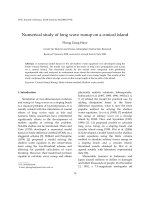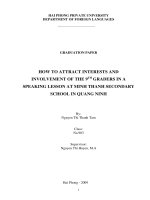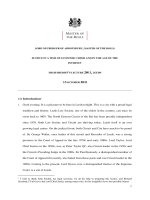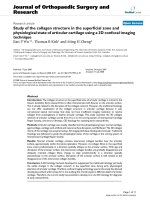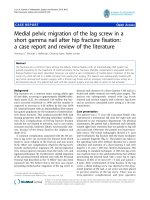Numerical study of the heat transfer in a miniature joule thomson cooler
Bạn đang xem bản rút gọn của tài liệu. Xem và tải ngay bản đầy đủ của tài liệu tại đây (7.66 MB, 152 trang )
NUMERICAL STUDY OF THE HEAT TRANSFER IN A MINIATURE
JOULE-THOMSON COOLER
TEO HWEE YEAN
NATIONAL UNIVERSITY OF SINGAPORE
2004
NUMERICAL STUDY OF THE HEAT TRANSFER IN A MINIATURE
JOULE-THOMSON COOLER
TEO HWEE YEAN
(B.Tech Mech. Engrg (Hons.), NUS)
A THESIS SUBMITTED
FOR THE DEGREE OF MASTER OF ENGINEERING
DEPARTMENT OF MECHANICAL ENGINEERING
NATIONAL UNIVERSITY OF SINGAPORE
2004
ACKNOWLEDGEMENTS
Acknowledgements
There are many friends, colleagues and lecturers as well as institutions to
whom I would like to express my thanks for their contribution and helpful
information.
I would like to express my thanks to Prof. Ng Kim Choon for his valuable
comments and useful assistance regarding the topics in heat transfer of fluids
and thermodynamics.
I would also like to mention thanks for the kind foreword and the ideas and
discussions from Assistant Prof. Chua Hui Tong and Dr Wang Xiaolin.
Last but not least let me express my warmest thanks to the National University
of Singapore and A*STAR for giving me the opportunity and full support,
without which this project could not have been completed.
Thank you.
National University of Singapore
Filename:TeoHY.pdf
i
TABLE OF CONTENTS
Table of Contents
PAGE
Acknowledgements
i
Table of Contents
ii-v
Summary
vi
Nomenclature
vii-x
List of Figures
xi-xiii
List of Tables
xiv
Chapter 1
1.1
1.2
1.3
Chapter 2
2.1
2.2
Introduction
1
Background
1
1.1.1 Recuperative Heat Exchanger
1
1.1.2 Regenerative Heat Exchanger
4
Present Trend
9
1.2.1 Open Cycle Cooling Systems
9
1.2.2 Inefficiencies & Parasitic Losses in Real Cryocooler
10
Objectives and Scopes
12
Joule-Thomson Cooler Fundamentals
16
Parameters & Characteristics
19
2.1.1 The Flows
19
2.1.2 Capillary Tubes
23
2.1.3 J-T Coefficients & Throttle Valves
25
Refrigeration Cycle
29
National University of Singapore
Filename:TeoHY.pdf
ii
TABLE OF CONTENTS
2.2.1 Stage 5 to 1
31
2.2.2 Stage 1 to 2
31
2.2.3 Stage 2 to 3
31
2.2.4 Stage 3 to 4
32
2.2.5 Stage 4 to 5
32
2.3
Hampson-Type J-T Cryostat
33
2.4
Experimental Model
37
Governing Differential Equations
40
Geometry Model
40
3.1.1 Helical Coil Capillary Tube
40
3.1.2 Helical Coil Fins
41
3.2
High Pressure Cryogen in the Helical Coil Capillary Tube
48
3.3
Helical Coil Capillary Tube
50
3.4
Helical Coil Fins
50
3.5
Shield
51
3.6
External Return Cryogen
51
3.7
Spacers
53
3.8
Entropy Generation for Internal Cryogen
54
Chapter 3
3.1
National University of Singapore
Filename:TeoHY.pdf
iii
TABLE OF CONTENTS
Chapter 4
Numerical Prediction
55
4.1
Computational Fluid Dynamics
55
4.2
Dimensionless Governing Differential Equations
57
4.2.1 High Pressure Cryogen (Single Phase Flow)
58
4.2.2 High Pressure Cryogen (Two Phase Homogenous Flow)
58
4.3
4.4
Chapter 5
5.1
4.2.3 Helical Coil Capillary Tube
58
4.2.4 Helical Coil Fins
58
4.2.5 Shield
58
4.2.6 External Return Cryogen
59
4.2.7 Entropy Generation
59
Properties and Areas
60
4.3.1 Fanning Friction Factors
60
4.3.2 Convective Heat Transfer Coefficients
61
4.3.3 Thermodynamic and Transport Properties of Argon
61
4.3.4 Thermal Conductivities of Materials
68
4.3.5 Heat Transfer Areas
69
Boiling Heat Transfer
70
4.4.1 Nucleate Pool Boiling
71
4.4.2 Pool Film Boiling
74
4.4.3 Jet Impingement Boiling
75
Results & Discussion
76
Temperature-Entropy (T-s) Diagram
77
National University of Singapore
Filename:TeoHY.pdf
iv
TABLE OF CONTENTS
5.2
Cooling Capacity
79
5.3
Coefficient of Performance and Figure of Merit
83
5.4
Effectiveness and Liquefied Yield Fractions
84
5.5
Temperature and Pressure Distributions
86
Conclusions & Recommendations
88
6.1
Conclusions
88
6.2
Recommendations
90
Chapter 6
References
R-1
Appendix A – Operation Manual for Simulation Program
A-1
Appendix B – Fortran 90 Source Code – Main Program
B-1
Appendix C – Fortran 90 Source Code – IMSL Subroutine (DBVPFD) C-1
Appendix D – Fortran 90 Source Code – IMSL Subroutine (FDJAC)
D-1
National University of Singapore
v
Filename:TeoHY.pdf
SUMMARY
Summary
The miniature Joule-Thomson (J-T) cooler is widely used in the electronic
industry for the thermal management of power intensive electronic
components because of special features of having a short cool-down time,
simple configuration and having no moving parts.
In this thesis, the sophisticated geometry of the Hampson-type J-T cooler is
analyzed and incorporated into the simulation, so that the model can be used
as a design tool. The governing equations of the cryogen, helical tube and
fins, and shield are coupled and solved numerically under the steady state
conditions, and yield agreements with the published experiments to within 3%.
The characteristics of flow within the capillary tube and external return gas are
accurately predicted. The temperature versus entropy, cooling capacity versus
load temperature, and cooling capacity versus input pressure charts are
plotted and discussed. The conventional way of simulating a Hampson-type JT cooler, which is accompanied by a host of empirical correction factors,
especially vis-à-vis the heat exchanger geometry could now be superseded.
The effort and time spent in designing a Hampson-type J-T cryocooler could
be greatly reduced. By avoiding the use of empirical geometric correction
factors, the model produces the real behavior during simulation.
National University of Singapore
Filename:TeoHY.pdf
vi
NOMENCLATURE
Nomenclature
A
Areas of contact
m2
cp
Isobaric specific heat
J/(kg.K)
Coef
Heat Transfer Coefficient
W/(m2.K)
cv
Isochoric specific heat
J/(kg.K)
D,d
Diameter of tubes
m
ds
Grid length along s-axis
m
ds
Dimensionless grid length along s-axis
-
f
Fanning friction factor
-
f(T,P)
f is a function of T and P
-
G
Mass velocity
kg/(m2.s)
h
Specific enthalpy
J/kg
k
Thermal conductivity
W/(m.K)
Ls
Total length of capillary tube
m
m&
Mass flow rate
kg/s
M
Molecular Weight
g/mol
Mv
Volumetric flow rate
SLPM
p
Perimeter of heat transfer area
m
P
Pressure
Pa or N/m2
Pitchm
Pitch of capillary tube
m
Pitchfin
Pitch of fins
m
Pr
Prandtl number =
National University of Singapore
Filename:TeoHY.pdf
Cpµ
k
-
vii
NOMENCLATURE
q
Heat transfer per unit mass
W/kg
Q&
Heat transfer
W
Ro
Universal gas constant
J/(kg.K)
Re
Reynolds number =
S&
Specific entropy
J/kg.s
T
Temperature
K
u
Average velocity of fluid
m/s
x
Quality of fluid
-
y
Liqufied yield fraction
-
ρUDH
µ
-
Greek Letters
α
Helical angle
β
Helical angle
γ
Non-linear coefficient
λ
Dimensionless conduction parameter
µ
Fluid dynamic viscosity
µJ-T
Joule-Thomson coefficient
σ
Stefan-Boltzmann constant
ρ
Fluid density
ε
Emissitivity
θ
Dimensionless temperature
Φ
Dimensionless pressure for hot fluid
National University of Singapore
Filename:TeoHY.pdf
viii
NOMENCLATURE
ψ
Dimensionless pressure for returned fluid
Superscipts & Subscripts
0
Initial state
1,2,3,4,5
State points
amb
Ambient or room temperature and pressure conditions
f
High pressure incoming fluid
fa
High pressure vapor state in two-phase condition
fl
High pressure liquid state in two-phase condition
finm
Contact between capillary tube & fins (Area)
fin
Capillary fins
fm
Contact between high temperature fluid and capillary tube (Area)
g
Saturated fluid in gas state
H
Hydraulic
hel
Helical
in
Inlet
l
Low pressure returned fluid
m
Capillary tube
man
Mandrel
min
Minimum
ml
Contact between capillary tube and returned fluid (Area)
out
Outlet
pc
Polycarbonate
National University of Singapore
Filename:TeoHY.pdf
ix
NOMENCLATURE
r
Radiation
ref
Refrigeration
s
Shield
sh
Shield
si
Shield inside
so
Shield outside
ss
Stainless steel
National University of Singapore
Filename:TeoHY.pdf
x
LIST OF FIGURES
List of Figures
Page
Figure 1.1
Classification of Recuperative Cycles Heat Exchangers
2
Figure 1.2
Regenerative Cycles Heat Exchanger
4
Figure 2.1
Joule-Thomson Cycle and Temperature-Entropy Diagram
19
Figure 2.2
Contours of velocity head non-dimensionalized with ½ρU2
21
Figure 2.3
Development of the axial velocity fields at Re=104 & Pr=7
21
Figure 2.4
Development of secondary velocity fields at Re=104 & Pr=7
22
Extracted from [21]
Figure 2.5
22
Mean axial velocity distribution and vectors of means
secondary flows in curved and helically coil pipes
Extracted from [20]
Figure 2.6
23
The CFD models for the ordinary helix centerline
Extracted from [24]
Figure 2.7
23
The streamline patterns near the top of the arch.
Extracted from [24]
Figure 2.8
Typical J-T Cryostat Nozzle Schematic Diagram
26
Figure 2.9
Schematic of J-T Inversion Curve
28
Figure 2.10 Basic Joule-Thomson Cycle
30
Figure 2.11 A Real Hampson-type Joule-Thomson Cryocooler
35
Figure 2.12 Schematic of Hampson-Type Joule-Thomson Cryocooler
36
Figure 2.13 Schematic of Experimental Apparatus
37
Extracted from [12]
National University of Singapore
Filename:TeoHY.pdf
xi
LIST OF FIGURES
Figure 2.14 Photograph of Experimental Apparatus Extracted from [12]
39
Figure 3.1
Helical Coil Notations – Capillary Tube
43
Figure 3.2
Helical Coil Notations – Fins
44
Figure 3.3
Elevation View of Helical Coil Capillary Tube and Fin
45
Figure 3.4
Plan View of Helical Coil Capillary Tube and Fin
46
Figure 3.5
Cross-Sectional View of Helical Coil Capillary Tube and Fin
47
Figure 3.6
Tf, Tl, Tm and Tfin Relations
50
Figure 4.1
Variation of Argon Density against Temperature
63
Figure 4.2
Variation of Argon Specific Heat against Temperature
63
Figure 4.3
Variation of Argon Entropy against Temperature
64
Figure 4.4
Variation of Argon Enthalpy against Temperature
64
Figure 4.5
Variation of Argon Viscosity against Temperature
65
Figure 4.6
Variation of Argon Thermal Conductivities against
65
Temperature
Figure 4.7
Temperature-Entropy Charts for Argon
67
Figure 5.1
Simulated T-s Diagram (CASE 1)
78
Figure 5.2
Simulated T-s Diagram (CASE 5)
78
Figure 5.3
Effect of the Load Temperature on the Cooling Capacity
79
Figure 5.4
Effect of the Input Pressure on the Cooling Capacity
80
Figure 5.5a Effect of the Normalised Volumetric Flowrate on the
81
Cooling Capacity
Figure 5.5b Effect of the Volumetric Flowrate on the Cooling Capacity
82
Figure 5.5c Effect of the Volumetric Flowrate on the Cooling Capacity
82
National University of Singapore
Filename:TeoHY.pdf
xii
LIST OF FIGURES
Figure 5.6
84
Coefficient of Performance and Figure of Merit under
Different Inlet Pressure
Figure 5.7
Variation of Effectiveness & Liquefied Yield Fraction under
86
Different Inlet Pressure
Figure 5.8
87
Temperature and Pressure Distribution along the Finned
Heat Exchanger
National University of Singapore
Filename:TeoHY.pdf
xiii
LIST OF TABLES
List of Tables
Page
Table 1.1
Performance of Regenerative Cryocoolers
8
Table 1.2
Advantages & Disadvantages of Store Expendable
10
Cryogen
Table 2.1
Maximum Inversion Temperature
28
Table 2.2
Approximate inversion line locus for Argon (Perry, 1984)
29
Table 2.3
Dimensions of J-T Cryostat
37
Table 2.4
Experimental Data and Measured Results of T1
39
Table 4.1
Specifications of Dimensionless Parameters
59
Table 4.2
Thermal Conductivities of Materials
69
Table 4.3
Heat Transfer Specifications and Areas
69
Table 5.1
A Comparison between Experimental Data & Simulated
77
Results
Table 5.2
Variations of Effectiveness, Liquefied Yield Fraction and
85
COP under Different Input Pressure
National University of Singapore
Filename:TeoHY.pdf
xiv
CHAPTER 1 INTRODUCTION
Chapter 1 Introduction
This chapter presents a brief introduction of the different types of cryocoolers.
Heat exchangers based on different types of cooling cycles, namely
recuperative and regenerative, were briefly discussed. The objectives and
scope of the project are discussed at the end of this chapter.
1.1
Background
1.1.1 Recuperative Heat Exchangers
The recuperative cryocooler is analogous to a DC electrical device in the
sense that the refrigerant flows steadily in a direction. This one-directional flow
is often an advantage because they can transport the refrigerant over fairly
large distances to do spot cooling at several locations. The recuperative heat
exchangers have two separate flow passages and the streams continuously
exchange heat with each other. Such heat exchangers are relatively
inexpensive to manufacture.
There are three basic types of regenerative heat exchangers. These are
characterized by their thermodynamic cycles of operation and names of
original investigators, namely Linde-Hampson, Claude, and Joule-Brayton.
The configuration details are shown in Figure 1.1 below.
National University of Singapore
Filename:TeoHY.pdf
1
CHAPTER 1 INTRODUCTION
COMPRESSOR
RECUPERATIVE
HEAT EXCHAGER
COOLING
J-T
VALVE
AFTER
COOLING
a) LINDE-HAMPSON TYPE HEAT EXCHANGER
COMPRESSOR
RECUPERATIVE
HEAT EXCHAGER
COOLING
J-T
VALVE
AFTER
COOLING
b) CLAUDE TYPE HEAT EXCHANGER
COMPRESSOR
COLD
EXPANSION
ENGINE
RECUPERATIVE
HEAT EXCHAGER
COOLING
COLD
EXPANSION
ENGINE
AFTER
COOLING
c) JOULE-BRAYTON TYPE HEAT EXCHANGER
Figure 1.1 Classifications of Recuperative Cycles Heat Exchangers
i. Linde-Hampson and Claude Type Heat Exchangers
The Joule-Thomson (J-T) cryocooler device is very similar to the
vapour-compression cycle used in household refrigerators except for
the use of a non-CFC refrigerant to reach cryogenic temperatures and
the need for a very effective heat exchanger to span such a large
National University of Singapore
Filename:TeoHY.pdf
2
CHAPTER 1 INTRODUCTION
temperature difference. In a domestic refrigerator, oil from the oillubricated compressor dissolves in the CFC refrigerants and remains in
solution even at the cold end.
The irreversible expansion that occurs at the J-T valve leads to cooling
only for non-ideal gases below the inversion temperatures. Nitrogen
and Argon gases are typically used for refrigeration at 77 K & 84 K
respectively, but the input pressure is usually about 200 bar in order to
achieve reasonable efficiencies. Hydrogen gas, pre-cooled by a
nitrogen stage, is used for refrigeration at 20 K, and a helium stage is
used to achieve 4 K. More often a 4 K J-T system is pre-cooled to 15 ~
20 K with a regenerative refrigerator.
Single-stage J-T coolers that use nitrogen or argon with miniature
finned-tube heat exchangers have been used in large quantities for
rapid (a few seconds) cool-down of infrared sensors. These open
systems use high pressure gas from a small storage cylinder.
ii. Joule-Brayton Type Heat Exchangers
Another common recuperative cryocooler is the Brayton cycle
refrigerator. An ideal gas such as helium or a helium-neon mixture can
be used on this cryocooler because of the reversible expansion that
occurs in either the reciprocating or turbo-expanders. As a result, only
National University of Singapore
Filename:TeoHY.pdf
3
CHAPTER 1 INTRODUCTION
one fluid is required for all temperatures and much lower pressure
ratios are needed.
This cycle is commonly used in large liquefaction systems (with a final
J-T stage) and it has a high reliability due to the use of gas bearings on
the turbo-expanders. This cycle is generally not practical or efficient for
refrigeration powers less than 10 W at 80 K because of the machining
problems encountered with such small turbo-expanders. As a result, its
application to the cooling of superconducting electronics is rather
limited.
Wc
Wc
Wc
Reservoir
Orifice
Qc,Tc
Qc,Tc
Regenerator
Displacer
Regenerator
Pulse
Tube
Regenerator
QE,TE
QE,TE
d) STIRLING TYPE
HEAT EXCHANGER
Qc,Tc
Qh,Th
e) PULSE TUBE TYPE
HEAT EXCHANGER
Displacer
QE,TE
d) GIFFORD-MCHAHON TYPE
HEAT EXCHANGER
Figure 1.2 Regenerative Cycles Heat Exchanger
1.1.2 Regenerative Heat Exchangers
The primary heat exchanger is known as a regenerator or a regenerative heat
exchanger. It consists of some form of porous material with high heat capacity,
through which the working fluid flows in an oscillating manner. Heat is
transferred from the fluid to a porous matrix (stacked screens or packed
National University of Singapore
Filename:TeoHY.pdf
4
CHAPTER 1 INTRODUCTION
spheres) during the hot blow (fluid flowing from the warm end) and returned to
the fluid from the matrix during the cold blow (fluid flowing from the cold end).
Because of the single flow channel, regenerators are very simple to construct.
The rapid decrease in heat capacity of most matrix materials at low
temperatures causes a rapid decrease in regenerator performance below
about 10 ~ 15 K.
As a result, all regenerative refrigerators are usually limited to temperatures
above 8 ~ 10 K. The cryogen in nearly all regenerative systems uses helium
gas. Temperatures down to about 50 K are usually achieved with single-stage
cold heads, whereas two or more stages are used to achieve lower
temperatures. From a thermodynamic stance, more stages lead to higher
efficiencies, but the additional manufacturing complexity shall be considered in
any practical device.
Typical frequencies of these cryogcoolers vary from about 2 Hz to 60 Hz. An
oscillating displacer causes the working fluid to be compressed when it is at
the warm end and to be expanded when it is at the cold end. There are four
basic types of mechanical cryocooler which incorporates regenerative heat
exchangers. These are generally classified by the thermodynamic cycle on
which they operate, specifically:
National University of Singapore
Filename:TeoHY.pdf
5
CHAPTER 1 INTRODUCTION
i. Stirling;
The Stirling refrigerator, which has the highest efficiency among all of
the regenerative cryocoolers, is the oldest and most common of the
regenerative systems. The Stirling cycle was invented for use as a
power system in 1816 and first commercialized as a cryocooler in 1954.
The schematic diagram of Stirling heat exchanger is shown in Figure
1.1 (c) above.
ii. Pulse Tube;
The pulse-tube refrigerator is a recent variation of the Stirling
refrigerator. The moving displacer is replaced by an orifice and
reservoir volume. The original version of the pulse-tube refrigerator was
developed in the mid-1960s, but a more powerful orifice version was
introduced in the 1980s. The pressure oscillation is most commonly
provided by a Stirling cycle compressor but a Gifford-McMahon
compressor and valves are sometimes used with a sacrifice in
efficiency.
In the pulse-tube refrigerator, the compressed, hot cryogen flows from
the pulse tube through the warm heat exchanger and the orifice. The
expanded cold cryogen in the pulse tube flows past the cold heat
exchanger when the cryogen from the reservoir returns to the pulse
tube. These systems are analogous to AC electrical systems.
National University of Singapore
Filename:TeoHY.pdf
6
CHAPTER 1 INTRODUCTION
Except for the Gifford-McMahon refrigerator, the compressor or
pressure wave generator in the regenerative system has no inlet and
outlet valves. As a result, it produces an oscillating pressure in the
system, and void volumes must be minimized to prevent a reduction in
the pressure amplitude.
A thermo acoustic driver was used to drive a pulse-tube refrigerator in a
joint project between National Institute of Standards and Technology
(NIST) and Los Alamos National Laboratory in 1989. It achieved 90 K
and became the first cryocooler with no moving parts. The schematic
diagram of a pulse tube cycle heat exchanger was shown in Figure 1.1
(d) above.
iii. Gifford-McMahon;
Gifford-McMahon refrigerator was developed in the mid-1950s using
the same type of cold head as the Stirling crycooler. However, the
pressure oscillation is generated by using valves switch between the
high and low pressure sides of an air conditioning compressor modified
for use with helium gas. Oil in the high pressure gas is removed by
extensive filters and adsorbers before the gas enters into the cold head.
The use of valves to provide the pressure oscillation greatly reduces the
system efficiency compared with the Stirling cryocooler, but it allows the
use of inexpensive oil-lubricated compressors. These Gifford-McMahon
refrigerators, now manufactured by the thousands from cryopumps,
National University of Singapore
Filename:TeoHY.pdf
7
CHAPTER 1 INTRODUCTION
magnetic resonance imaging shield cooling, ground-based satellite
communications systems, and research applications, are available in
both one and two stage units. The schematic diagram of GiffordMcMahon heat exchanger is shown in Figure 1.1 (e) above.
iv. Vuilleumier.
Vuilleumier cryocooler uses an input of thermal energy at high
temperature to generate cyclic pressure fluctuations of the cryogen
contained in the closed volume of the unit. The pressure variations
were produced by the action of a reciprocating displacer shuttling the
working fluid periodically from an ambient temperature space to a high
temperature space through a regenerator. Extremely low temperature
up to 0.1 K can be produced by this approach.
The performance of regenerative cryocoolers is summarized in Table 1.1
below:
Table 1.1 Performance of Regenerative Cryocoolers
Cooler
Temperature
Range
300 → 50 K
Cooling
Power
100 mW / 5 W
Pulse
Tube
May replace
G-M
and
Stirling
Coolers in the
near future
GiffordMcMahon
300 → 2.5 K
5 W / 200 W
1 W / 20 W
Vuilleumier
100 → 0.1 K
µ W / few W
Stirling
National University of Singapore
Filename:TeoHY.pdf
Advantages
Simple
Compact
No moving parts
Compact
Robust
No moving parts
Reliable
Simple
Robust
Reliable
Compact
No moving parts
“Unlimited” lifetime
Fully passive
Disadvantages
Poor efficiency Limited
autonomy (one shot),
Susceptibility
to
gas
purity
Efficiency may be slightly
lower than Stirling
Poor efficiency
Induced vibrations
Limited autonomy
Poor efficiency
8
CHAPTER 1 INTRODUCTION
1.2
Present Trend
For the J-T cryocooler, significant improvement in efficiency has been made in
the last few years by replacing pure nitrogen or argon with a mixture of
nitrogen, methane, ethane, and propane. Temperatures of 80 K can be easily
achieved with four or five times the efficiency of a nitrogen system with a lower
pressure on the compressor output. An efficient, long-life compressor for a J-T
refrigerator is still needed, but till to-date, no one has produced a
comprehensive and accurate engineering model that predicts and analyses
the behavior and flow of the cryogen in the cryocooler.
1.2.1 Open Cycle Cooling Systems
A widely used method for low capacity cryogenic refrigeration cycle involves
the use of a stored, cold, expendable cryogen which eventually vaporizes and
is vented to the atmosphere. The principal method is a solid, liquid or gas
vaporizes and escapes from the storage dewar. The dewar may be opened to
the atmosphere or sealed with a vent valve so that it is operated under
pressure.
The advantages and disadvantages of the stored expendable cryogen are
tabulated below:
National University of Singapore
Filename:TeoHY.pdf
9




